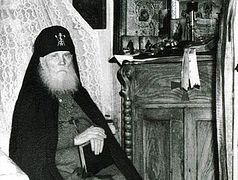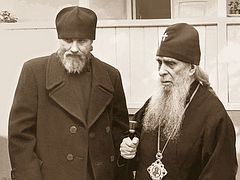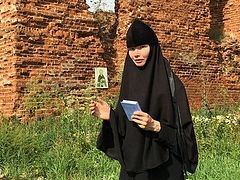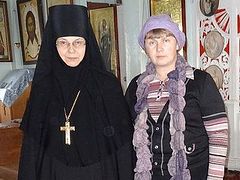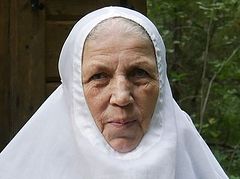The book “Optina Pustyn and its times” gives the following definition of “starchestvo” [“eldership”.—Trans.]: “True starchestvo is a special gift of grace, a kind of charisma, a direct guidance by the Holy Spirit, a particular kind of holiness.” Ivan Kontsevich, a writer and theologian of the Russian diaspora who saw and experienced the old Optina—an experience that would spiritually nourish him for the rest of his life—wrote the following: “Optina was like a chalice in which every kind of precious wine was mingled.” The revolution in 1917 furiously poured this “precious wine” out and trampled it down in an attempt to have no trace of it left. But the Lord is merciful: how many ascetics bearing the gifts of spiritual discernment, humility, meekness, clairvoyance and unceasing prayer has He made manifest to us in our modern times! The names of some are known by many of the faithful, while the names of others are made known through conversations with those who remember and revere them. In the following interview, Abbess Seraphima of the St. Peter and Paul Convent in the town Yuriev-Polskiy, Alexandrov diocese (Vladimir Metropolia) has shared her reminiscences with us.
“It was a different kind of life”
—Matushka, in your last interview “The way full of light”, you said that you went through a true school of monasticism at the St. Nicholas convent in Novoe village, located 12 kilometers away from Yuriev-Polsky, and that you saw three eldresses there. Let us remember the words of Metropolitan Anthony of Sourozh: “It’s important to see the shining of eternal life in the eyes of another person at least once”. You on the other hand have been seeing this for many years. But what was it back then that brought you, a young woman from Moscow, to an unknown rural monastery?
—I once heard about an elder—schema-archimandrite Gideon (Abramov)—from a distant relative whom Fr. Gideon had healed. I knew that the doctors had diagnosed her with lung cancer and that she didn’t have much time left to live. But I asked my mother about her once and was extremely surprised to hear that she had recovered! My mother said she had visited an elder, after which her illness left her. Some time passed, and I met with this woman and asked her to tell me about the elder. She told me with much love and detail about the community that formed around schema-archimandrite Gideon in Novoe village, about its labors in the convent, about the services there, and most importantly—about father Gideon, whom she loved and revered for the rest of her lime. It was an amazing story, and I wanted to see the elder as soon as I could. However, at that time I always had, as it seemed to me, some kind of important errands that could not be set aside. So, for this reason I was always postponing my trip. When I finally came to Novoe village, Fr. Gideon had already reposed in the Lord. I was coming together with my friend from the capitol of our country—Moscow. I don’t think it’s even necessary to say that the only things we knew about village life was from movies and books. We’d only ever seen horses, cows and other livestock on television. The sisters of the convent, together with schema-nun Olga, the oldest, cheerfully greeted us Muscovites. We came during the most difficult time for the convent—during haymaking. Everyone was pretty tired and in need of some “reinforcements”. Oh, how hard we worked then! City folk—and haymaking! It seemed that from all this inconceivable physical labor we wouldn’t even be able to get out of bed the next day. However, the next day we didn’t just get up—we flew out of bed as though we had acquired wings!
—Was this trip your first step towards the monastic life?
After visiting the monastery I had a complete change of my view on life, if I may say so. But I was still far from coming to a conscious decision of entering the monastic life. I did try to visit Novoe village whenever I had the chance, because life there was different; it seemed like you even breathe differently there. But I never thought about monasticism. I knew that it was something one is called to and that monks are a special kind of people that the Lord has called to Himself. But Mother Olga, I believe, felt that monasticism was my calling. She kept inviting me to stay at the monastery. I decided to get advice from the hieromonk that was serving at the convent. He in turn blessed me to ask archimandrite Kirill (Pavlov). I came to Fr. Kirill in Peredelkino in full confidence that he would say: “What are you going to do at a monastery?” But instead, after thoroughly asking me about everything, he suddenly blessed me to enter the monastery. But I knew what the monastic life was like from the inside, not just by the books. And I did not see myself living that kind of life. I was so “lost” that I decided to visit Fr. Kirill again with the same question. I said to him: “Dear father, you’re probably mistaken! You know what the monastic life is like”. But he placed my head on his lap and again blessed me to enter the monastery. I understood then that this is the will of God, that this is my way. So I began preparing for the monastic life. How amazingly the Lord arranges one’s life through such elders! I must note that Fr. Kirill back then already knew about the work that lay ahead of me in restoring the convent back from ruins. There is much pain in my heart over the fate of the St. Peter and Paul convent, of which I am the abbess. I remember Fr. Kirill’s words: “Work hard; work to the glory of God, for the Lord!” which he repeated to me a few times as I was leaving. I did not really understand the meaning of his words then…
—How does one understand that the person standing before you is like a “conductor” of God’s grace? When reading about well-known elders, glorified by the Church, you can see that some of the people of their time considered them ordinary people or just outright strange people who give blessings for strange things and uttered incomprehensible advice, the meaning of which was often only understood after some time. Did you immediately realize that the nuns before you were eldresses?
Of course not. Everything was revealed gradually then, whereas now everything is clear. In the monastery in Novoe village I saw three nuns: Nun Moyiseya, Schemanun Gabriela and Schemanun Anna. They were amazing nuns—true athletes of Christ and the Mother of God, Whom they honored with much diligence. All of their thoughts and feelings were dedicated to the Lord and the Mother of God. The mothers lived strictly in solitude and prayer. They practically ate only prosphora and drank holy water. And the Lord gave them not only spiritual strength, but physical strength too. Schemanun Gabriela and Schemanun Anna had cancer, but lived in the convent for over twenty years with such an illness! Can you imagine that? I’d like to tell you a bit about each of the mothers separately.
Nun Moyiseya was born in a large peasant family and was baptized as an infant. She had a strict and pious father who would allow those who were in need to stay at his home, where they could receive food and even clothing if needed. That’s how nun Moyiseya remembered her childhood. She left the village to make a living in Moscow. Having enormous physical strength she worked at the Kurskaya railroad as a railway porter. Her spiritual father was Schema-Igumen Sabbas (Ostapenko), who now rests in peace in the God-created caves of the Pskov-Caves monastery. At the time when Fr. Gideon was still around, mother Moyiseya’s obedience was to take care of the church. She loved the services. Until the very last days of her life she would come to church for service before anyone else, regardless of the weather or any of her age-related infirmities. She always had a prayer rope in her hands. Whether she was sitting or lying down, she was always praying with her prayer rope. The sisters were kind of afraid of her. As it seems to me now, she had the blessing (such were her spiritual fathers!) to act as a fool for Christ’s sake. I once asked her about that, but she just looked at me, laughed, and didn’t say anything. She was a kind of spiritual doctor for all of us. In Yuriev-Polsky there was only one monastery at the time, in Novoe village. The faithful would come from the entire city here for feast days, and everyone loved to stop by at Mother Moyiseya’s home, even though she was very strict. She was 84 years old, but retained a clear memory; she remembered the names of everyone who asked for her prayers. The Lord had given her such abundant grace that she had no care for what she ate. She could eat stale, moldy bread with the same appetite as we eat cake. When speaking with her you’d be struck by amazement, because sometimes in the blink of an eye her face would “transfigure”, it would become “radiant” all of a sudden! She reposed in a state of peace and tranquility.
As for Schemanun Gabriela, we practically know nothing about her life before she entered the convent. The only thing we knew was that she survived the Leningrad blockade, and even during that extremely difficult time would share her food with her nephews. The Lord granted her the gift of spiritual discernment. I would run to her to confess my thoughts. She was skinny, hunchbacked, always cheerful and hardworking. I never saw her sitting around doing nothing. Mother Gabriela carried out her obedience in the church—she took care of the church and was responsible for decorating it, for gilding the iconostasis. I first met her when I was given the blessing to help with cleaning up the church. She came up to me after some time had passed and said, “Your dress is clean. Here, put this on.” And she gave me her old cassock. At that time I had just started coming to the convent to work and to just get a breath of the soul-healing “oxygen” there. Later on, when I had entered the convent, schema-nun Gabriela once came up to me in church before service and handed me some papers, saying: “You’ll need these”. I still have those papers, on which she herself wrote. They contained the order of the monastic tonsure and the vows one gives during the tonsure. I once came up to her to confess my thoughts. She was sitting down, but her face was red. She kept wiping and wiping an icon with a ball of cotton, and all of a sudden the darkened image of our Savior on the icon became clear. And then she says to me: “Wait a bit, let me rest some fifteen minutes on the benches here (she was working in the church) and then we’ll talk”. When I offered to take her to her cell, she refused. I then arrogantly answered: “Mother, what are you doing?! You can lie down in your cell for as long as you need and then come back”. “No”, she said, “I’m in a hurry”. “Where to?” I asked surprisingly. “Don’t tell anyone. The Mother of God came and said the Lord will take me away after I finish gilding the church!” At that moment I was tempted by worrying doubts about her. But only after her death did I realize how deep a spiritual life she truly had. We’re all afraid of death. But she had experienced eternity and was in a hurry to get there! She told the sisters that were looking after her that she would come to church on the patronal feast day of the monastery. Everyone was surprised to hear that, because Mother Gabriela, according to the doctors, had just a small number of days left to live. She reposed calmly and peacefully on December 17, the feast day of St. Barbara the Great Martyr. The 19th of December, our convent’s feast day, was the day of her burial service…
—What about the other eldress?
—That would be Schemanun Anna. She’s known better as Nun Olympiada. She was born to a pious family in Sima village of the Yuriev-Polsky district. Her father was the warden of the church of St. Dimitry the Great Martyr. In the world she received a higher education and taught math and physics at a school in Yuriev-Polsky city. She was the first to be tonsured a nun by Fr. Gideon in Novoe village. She was a devoted spiritual child of his, knew everything about him, and remembered every significant date associated with his life. She revered Fr. Gideon until the end of her life. At the convent she bore the obedience of altar attendant and prosphora baker. She was a skilled prosphora baker, well-known for it by the entire neighborhood. Though she was physically weak (she had stomach cancer), she was the “right hand” of Fr. Gideon, his indispensable assistant. I’ve never heard any kind of words of judgment or discontent from her. With tears in her eyes she’d often say: “Glory to God for everything!” She was also distinguished by her total non-possessiveness. The lampshade of her table lamp was made out of a lid from a tin can of herring. She taught me that if an item of clothing lies on the street for three days and no-one takes it, then it’s yours. That’s the kind of clothing a monk should have! She lived alone. She always had a prayer rope in her hands. I remember how she was very worried that she did not have the prayer of the heart. You would come to her with your thoughts for confession, would cry and say: “Such and such a sister offended me”; and she would sort everything out and quote something from the Holy Fathers, and would advise you to go and reconcile with your “offender”. Or she might say: “Go through your entire prayer rope once with a prayer the one who offended you”. And that helped—you wouldn’t feel anything against that person anymore! Your grudge would simply evaporate! Mother was not prone to talking much, she was always very concentrated. Sometimes laypeople would come to her for advice, regarding her as a eldress, but she would always “diminish” herself. Sometimes in answer to someone’s question she would stretch her hand out and say: “My hand hurts so much! There’s a fracture here, a dislocation here, and a partial dislocation over here.” She was humble and didn’t want to show that she had the grace of God. Having lived a very long life Schemanun Anna reposed in the Lord on Holy Thursday when she was 94, and her burial service was held on Great Friday. She likewise reposed in a state of peace and tranquility.
What exactly is an elder or eldress in a monastery? A monk or nun that has lived in the monastery long enough and through personal experience has gone through all the “steps” that you personally are still going through. When you ask such a person for advice, he’s able to help by saying how you should act or what you should do. And after receiving his or her advice you’re able to see everything from a different perspective. Little by little you get the hang of fighting with your own self, your own passions, rather than with your neighbor. I’m thankful to God that I had the opportunity to live in this convent in Novoe village with these ever most dear to me “grannies”! I thank God that I experienced such warmth from their love, that their prayer strengthened me and helped me live. Grant rest, O Lord, to the souls of Your departed servants! As for the St. Nicholas convent, I can sincerely say that it has become a spiritual school for me which now helps me, along with my hope in the Lord, to continue working on restoring the ancient convent of St. Peter and Paul in Yuriev-Polsky.
The foundation of obedience is trust
—Mother, what else was told about Fr. Gedeon in the convent?
—On the one hand this is a difficult question for me, because I didn’t get the chance to see the elder myself; and on the other hand an easy one, because the older nuns of the convent would talk about Fr. Gedeon every day. From what they told about him I learned that he was both strict and loving. He bore the obedience of being the spiritual father of the Vladimir district of the Vladimir and Suzdal diocese. It was also known that he finished the Moscow Theological Seminary, which was reopened in the Novodevichy monastery after the Great Patriotic War [World War II]. He studied there together with the future elder and archimandrite Kirill (Pavlov).
Fr. Gideon had many spiritual children. People from all over the district and all over Russia would come to him with their sorrows and joys. He loved and cared for the people. He selflessly met everyone who came to him, sometimes even sacrificing his own sleep and health. He would be sure to give them their blessing, listen to them, and give advice. He would administer Holy Unction to those who were physically ailing. The older nuns were especially amazed at him and became more devoted to prayer by seeing his reverent love and care for the services, for the icons. Fr. Gideon would come to church long before services started. He prayed before every icon (as the mothers would say, “he talked to them”) and only then would enter the altar. And of course everyone knew that he would never start the service without reconciling with those to whom he, perhaps, might have said something sharply the day before because of their negligence or laziness in carrying out their obediences.
The sisters of the convent loved Fr. Gideon. They understood how important it is to trust in God and the person through whom God reveals His will, to live in obedience. Schemanun Anna (or nun Olympiada before the Great Schema), once “let it slip” that she witnessed something that happened when she was serving in the altar together with Fr. Gideon. Once in the altar she very clearly saw a tall, beautiful Lady in brown clothes, standing sideways towards her. She was surprised: how could a woman have entered the altar? She blinked, and the vision was gone. Mother Olympiada, having understood everything, came up to Fr. Gideon and told him what had happened. “Don’t you dare say anything about it!” he warned in the strictest way. And while father was alive, she never told anyone about what she saw then. Only years after Fr. Gideon’s repose did she, by then an aged schemanun, tell me that the Mother of God served in the altar together with Fr. Gideon!
—Figuratively speaking, Schema-Archimandrite Gideon’s name was inscribed on the brick that laid the foundation of the revival of Russian monasticism after an era of difficult and godless times.
—Yes, that’s exactly how it was.












